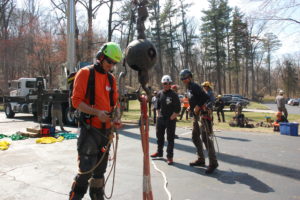The application of friction in tree climbing and rigging can be a huge benefit to controlling movement. Depending on where friction is located in a rope system in reference to the load is a critical consideration for the climber and the rigger of trees. Where friction is introduced into a rope system supporting a load can have a direct affect on cycles to failure of a rope, because greater loads reduce cycles to failure. And although friction management is an amazing way to transfer energy and potentially reduce loads depending on how it is used, friction may also potentially add to the stress that certain parts of a rope experience.
Consider this as it defines cycles to failure from The Art and Science of Practical Rigging: “One cycle means one lift or drop for a rigging line. Each cycle creates permanent damage in the rope, and eventually the rope will fail. At larger loads, the number of cycles to failure is reduced” (Donzelli, Lilly, 37).
Depending on how we employ each of our individual ropes (climbing, rigging, tagline, etc.) those ropes are individually exposed to different loads. Rig lines may consistently be exposed to larger loads than a rope that is primarily used for climbing.
But let’s now add friction into the equation.
In natural crotch rigging and when employing aerial friction devices, and even rigging rings to a certain extent, we are placing friction at the rigging point. The flip side of the coin would be the example of utilizing a rigging block at the rigging point, which has much less friction because of the bushings or bearings that the sheave spins on. To add friction when utilizing a block, we place it at the base of the tree in the common form of a friction bollard. So the basic scenarios here are either friction at the rigging point, or friction at the base of the tree, for this very general discussion.
“Using a natural crotch as the rigging point creates a substantial amount of friction at the rigging point. If there is friction at the rigging point, then the force between the crotch and the working end of the lowering line (the lead) will be greater than that between the crotch and the running end (the fall)” (118).
From this excerpt we observe that when friction is present at the rigging point, the lead of the rope experiences more force. Over time, the cycles to failure are less because of that larger force in that specific section of the rope.
Now consider the other portion of the scenario from before, when friction is placed further back in the rigging system so to speak, at the base of the tree in the form of a bollard.
“With a low-friction block and friction device, the entire length of rope from the working end, through the block and to the lowering device is available to absorb the energy of the falling wood, producing lower forces overall” (118).
Then, when more rope is entered into a system, providing more distance between the load and the friction being applied, there is less force on the rope itself, therefore increasing the cycles to failure that the rope can withstand. The downside to this type of rigging is that the tree itself experiences more of that force.
So there is definitely a give and take in the exact location of friction application. Every situation is very unique in the sense of how force must be distributed, and there is no substitute for experience in that arena of decision making.
When specifically considering cycles to failure ropes though, it is a good thing to keep in ming when utilizing aerial friction devices in rigging systems, and especially when rigging out very large loads that are near the working load limit of a line, that the lead of the rope when friction is at the rigging point will experience greater loads. This reduces the cycles to failure on these ropes, and should be kept in mind when considering the safety of specific gear in the working rotation.
This also got me thinking about my climbing system, too. Because I often climb on the rope wrench, my friction in my climbing system is constantly at the load itself (me, the climber), and I pondered a bit on how this affects the cycles to failure of a climbing line. Compared to a moving rope system that is moving on a super-smooth pulley, compared to a moving rope system that is moving through a natural crotch, compared to a stationary rope system that is running through a cammed belay device. Although a climbing line more or less experiences more consistent loading I feel, all of these different climbing styles and different climbing devices have me intrigued on how friction that moves with the load may affect cycles to failure. If even on a very minute level, it has peaked my interest because of how critical understanding the reality of rope life is.
“…each cycle creates permanent damage…”
Not something to be taken lightly.





Leave a Reply
Your email is safe with us.